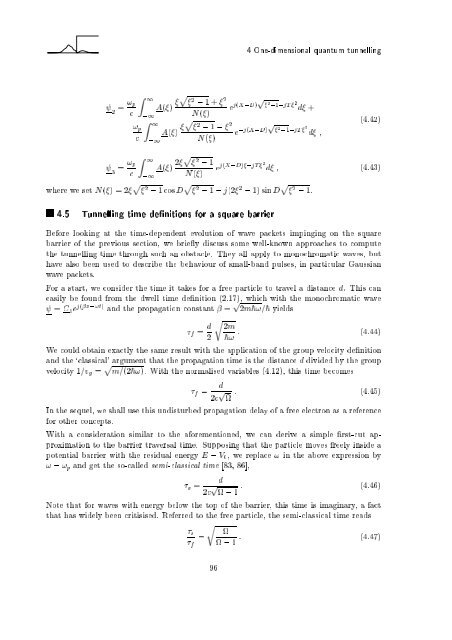Wave Propagation in Linear Media | re-examined
Wave Propagation in Linear Media | re-examined
Wave Propagation in Linear Media | re-examined
Create successful ePaper yourself
Turn your PDF publications into a flip-book with our unique Google optimized e-Paper software.
2 = !p<br />
c<br />
3 = !p<br />
c<br />
!p<br />
c<br />
Z 1<br />
,1<br />
Z 1<br />
Z 1<br />
,1<br />
,1<br />
A( )<br />
A( )<br />
p 2 , 1+ 2<br />
4 One-dimensional quantum tunnell<strong>in</strong>g<br />
e<br />
N( )<br />
j(X,D)<br />
p<br />
2,1,jT 2<br />
d +<br />
p<br />
2 2 , 1 ,<br />
N( )<br />
A( ) 2 p 2 , 1<br />
N( )<br />
e ,j(X,D)<br />
p<br />
2,1,jT 2<br />
d ;<br />
(4.42)<br />
2<br />
j(X,D) ,jT<br />
e d ; (4.43)<br />
whe<strong>re</strong> we set N( )=2 p 2 ,1 cos D p 2 , 1 , j(2 2 , 1) s<strong>in</strong> D p 2 , 1.<br />
4.5 Tunnell<strong>in</strong>g time de nitions for a squa<strong>re</strong> barrier<br />
Befo<strong>re</strong> look<strong>in</strong>g at the time-dependent evolution of wave packets imp<strong>in</strong>g<strong>in</strong>g on the squa<strong>re</strong><br />
barrier of the p<strong>re</strong>vious section, we brie y discuss some well-known approaches to compute<br />
the tunnell<strong>in</strong>g time through such anobstacle. They all apply to monochromatic waves, but<br />
have also been used to describe the behaviour of small-band pulses, <strong>in</strong> particular Gaussian<br />
wave packets.<br />
For a start, we consider the time it takes for a f<strong>re</strong>e particle to travel a distance d. This can<br />
easily be found from the dwell time de nition (2.17), which with the monochromatic wave<br />
= C1ej( x,!t) and the propagation constant = p 2m~!=~ yields<br />
f = d<br />
2<br />
r<br />
2m<br />
: (4.44)<br />
~!<br />
We could obta<strong>in</strong> exactly the same <strong>re</strong>sult with the application of the group velocity de nition<br />
and the `classical' argument that the propagation time is the distance d divided by the group<br />
velocity 1=vg = p m=(2~!). With the normalised variables (4.12), this time becomes<br />
f = d<br />
p : (4.45)<br />
2c<br />
In the sequel, we shall use this undisturbed propagation delay of a f<strong>re</strong>e electron as a <strong>re</strong>fe<strong>re</strong>nce<br />
for other concepts.<br />
With a consideration similar to the afo<strong>re</strong>mentioned, we can derive a simple rst-cut approximation<br />
to the barrier traversal time. Suppos<strong>in</strong>g that the particle moves f<strong>re</strong>ely <strong>in</strong>side a<br />
potential barrier with the <strong>re</strong>sidual energy E , V0, we <strong>re</strong>place ! <strong>in</strong> the above exp<strong>re</strong>ssion by<br />
! , !p and get the so-called semi-classical time [83, 86],<br />
d<br />
s =<br />
2c p : (4.46)<br />
, 1<br />
Note that for waves with energy below the top of the barrier, this time is imag<strong>in</strong>ary, a fact<br />
that has widely been critisised. Refer<strong>re</strong>d to the f<strong>re</strong>e particle, the semi-classical time <strong>re</strong>ads<br />
s<br />
f<br />
=<br />
r<br />
96<br />
: (4.47)<br />
, 1












